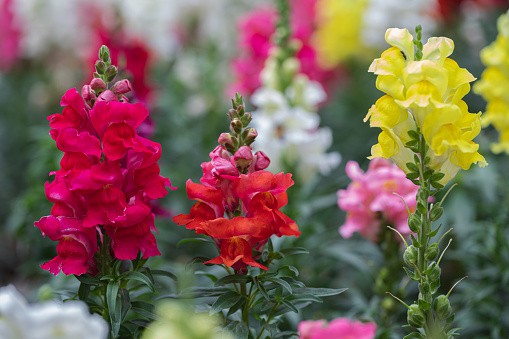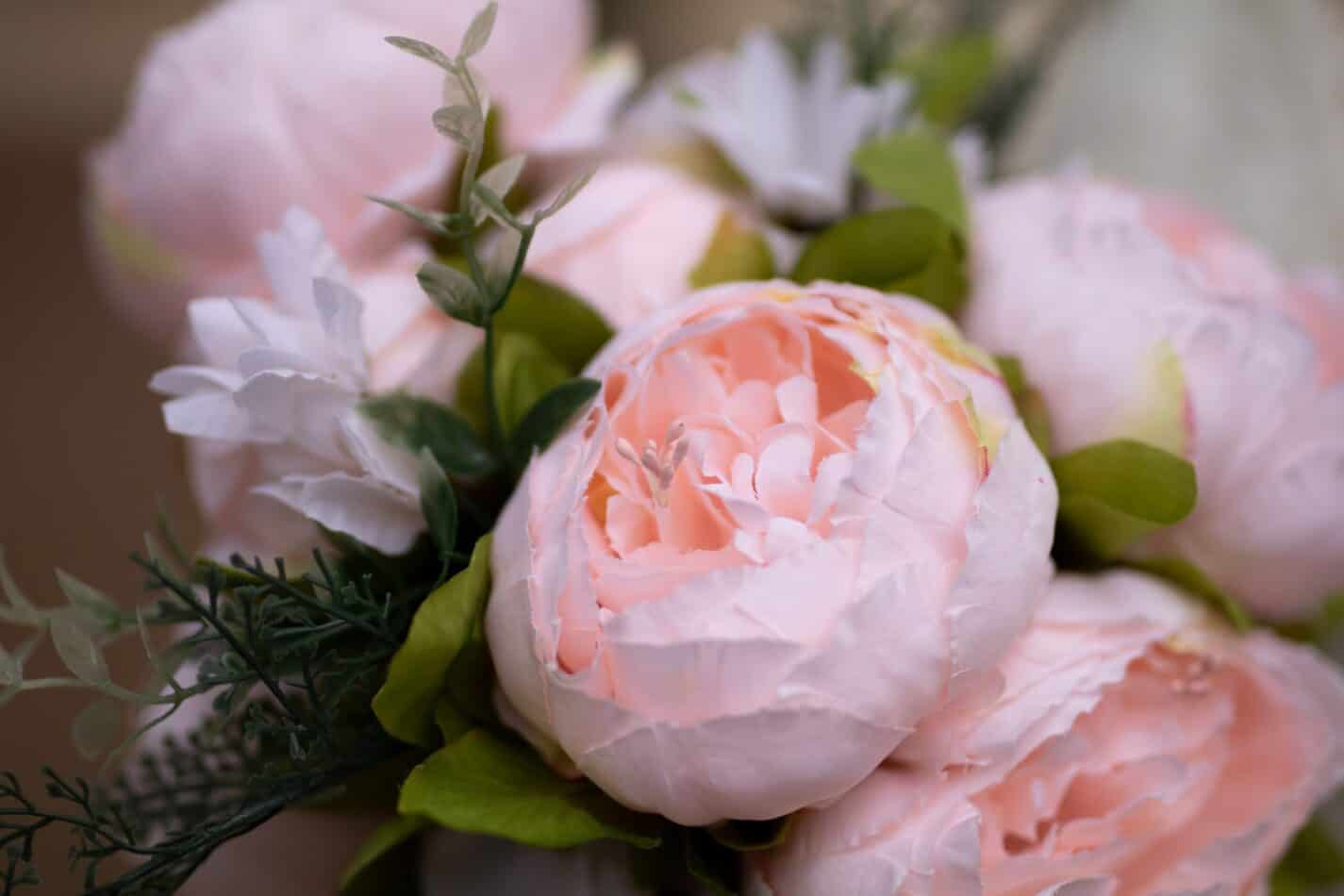The antirrhinum majus, commonly known as snapdragon, is a botanical species of the plantain family Plantaginaceae. The origin of its suggestive common name, snapdragon, is derived from its physical interaction with a gentle squeezing of its throat, in turn causing the flower to open like a mouth and snap back shut. It carries with it a sense of play and animation, which children and avid gardeners alike can appreciate. This flower is a short-lived perennial, however it is traditionally and commonly grown as a seasonal annual, blossoming from spring until fall.
Snapdragons grow in an array of brightly colored blooms, giving off a distinct and subtle fragrance. The plant grows best when exposed to direct sunlight and can tolerate various soil levels, although preferring fertile, well-drained soils. As a member of the plantain genus, it is known for being attractive towards bumblebees, hummingbirds and butterflies. Being a low-maintenance flower, it is suitable for both indoor and outdoor potting.
Etymology
The word antirrhinum originates from the Greek words ‘anti’ meaning like and ‘rrhin’, meaning nose, referencing to the peculiarly shaped flower and snapdragon from the way it interacts to being squeezed on its neck.
How to Plant
Snapdragons can be grown from either seeds or cuttings, and it is recommended to either start planting indoors in early spring, or in early autumn for outdoor seeding. It is advisable that seeds are planted into very light seedbeds and require a temperature range of 18 degrees celsius and above during germination. During establishment, snapdragons need a consistent moist soil whilst also allowing it to dry out in between watering. Furthermore, they will require a warm and dry environment in order to thrive.
When planting snapdragons in the ground, it is essential to dig over the area and remove any weeds in order to achieve the best soil structure possible. When planting the seeds themselves, they ought to be spread evenly and lightly raked over before applying a light layer of compost or topsoil. Once planted, the seeds should be regularly thinned to prevent overcrowding, having an optimal spacing of 15 centimetres and should receive an application of slow-release fertilizer in order to promote a long period of sufficient nourishment.
Meaning and Symbolism
Snapdragons have long been steeped in symbolism and flower meaning ranging from protection from malevolence, the promotion of strength, and a sign of the grandiosity of the giver. Specifically, snapdragons have long been a preferred flower of the Victorian era when used in bouquets and love letters to symbolise both reverence between friends and lovers and the sacred icon of being bold and unbridled.
History, Mythology and Religious Significance
Solidifying it’s mystique, snapdragons were believed to have hidden powers such as making the gift-holder appear taller by the powers of the flower itself. According to Greek mythology, the snapdragons were believed to have first of been created in the shape of a dragon. Zeus, the God of the Heavens had `fought a fierce dragon named Zorr, in order to save mankind from its vicious jaws. Afterward, Zeus tended to the dragon’s wounds with a balm of sweet nectar and transformed him into a beautiful flower.
Symbolising its story, snapdragons have long been used as a lucky charm for protection both physically and spiritually. Expressing your reverence for another or offering your protection, snapdragons were used in the production of protective amulets and had the power to protect from the “evil eye” or to ward off spiritual danger.
Flower Varieties and their Defining Characteristics
There is an abundance of snapdragon species available, ranging from delicate pastel petals to polka-dotted varieties. Primarily, the snapdragons are categorised as ‘tall’ or ‘dwarf’. Longer stemmed flowers such as ‘Royal Bride’, ‘Leicester’, and ‘Snowstorm Picotee’, are considered the ‘tall varieties’ and reach heights of up to 60 centimetres. Dwarfs, on the other hand, being much smaller varieties such as ‘Silver Queen’, ‘Tom Thumb’, and ‘Liliput Purple’, will reach a maximum of 15 centimetres.
Another distinction between certain varieties of snapdragon also include their colour and shades. Drawing from a wide palette of hues from white, lavenders, yellow, oranges, and pinks, some varieties may also come with unique markings such as freckled petals or feathered stems. Additionally, some of the unique features that certain species have, have been used by fine breeders to produce interesting colour patterns within one flower as well as two-tone shades.
How to Pot and Repot
With a preference for good drainage, it is essential to choose the correct pot size and material when potting or repotting your snapdragons. Any pots intended for use should at least be 17 centimetres in diameter and, when mixing the soil, it is important to add a layer of stones or charcoal to help facilitate excellent drainage. When done correctly, repotting is a simple affair that helps to promote and encourage healthy growth for even the most time-sensitive flowers.
When repotting, be sure to mock the same environment as if in the garden and add a layer of stones to the bottom of the pot, cover it with a healthy layer of well-draining soil preservative, and finally, fill the rest of the pot with good quality potting soil. Place the rooted stems of the flower near the edge of the pot, add more soil and lightly press-down on the surface before watering them well with room temperature water.
How to Prune
As the blooms of snapdragons inevitably start to die, pruning the flowers is a strategy to refresh the flowering process or reinvigorate the display of colour. When pruning, the aim is to snip off spent blooms, encouraging the plants to produce more flowers and to promote bushier growth as not all plants that flower from the base need to be pruned heavily.
Cut a snapdragon stem above a rosette of leaves and, if needed, perform a light trim on the sides and back of the leaf-growth. Hand pruning, rather than the electric shearers, is best to help reduce the risk of damaging the sensitive, fleshy stems. Pruning can be done both in spring and autumn and can help to deter the affects of mildew.
How to Propagate
Propagating snapdragons is best done in early spring, usually during February and March. To do so, snapdragon cuttings must first be taken, with a pair of clean, sharp scissors, no more than 6 centimetres long and must contain at least three leaves and one bud. Once the cuttings have been taken from the main stock, it is then time to root the cuttings.
A small pot with a well-draining, sandy soil should be prepared for the propagation process. When placing the cuttings into this soil, ensure the basal nodes are still beneath the surface. The cuttings need to be constantly monitored in terms of water consistency, as it should neither be too wet or too dry. Once planted and taken proper care of, the cuttings should start rooting and become a healthier, bushier plant.
Common Pests and Plant Diseases
Snapdragons are relatively low-maintenance, however they can still be affected by common pests, such as aphids and thrips, as well as diseases, usually at the younger stages of growth. A common problem that developers encounter when growing snapdragons is leafspots. Leafspots are fungal problems that occur from too much nitrogen, over-watering and temperatures below 18 degrees celsius. To prevent leafspots, it is advised to choose resistant varieties, provide sufficient air circulation and adequate spacing between plants and keep away from excessive nitrogen fertilisation.
Concurrently, thrip and aphid damage often occurs when the climate is warm, usually during the summer months, as they become attracted to delicate plants. Thrips will suck the sap and taint flowers, whereas aphids will attack more vigorously, nibbling at any fleshy parts. To prevent such damage, it is best to use insecticides, having a particular emphasis on soft-bodied aphids, and to thoroughly inspect all purchased snapsdragons prior to shooting.
Frequently Asked Questions
Q: Where does the name ‘snapdragon’ come from?
A: The name for snapdragon is derived from it’s physical interaction with a gentle squeezing of its throat, in turn causing the flower to open like a mouth and snap back shut.
Q: What colours do snapdragons come in?
A: Snapdragons can be mainly categorised as either yellow, lavenders, yellow, oranges, and pinks, but some varieties may also come with unique markings such as freckled petals or feathered stems.
Q: What temperature range is ideal for snapdragons?
A: Snapdragons will require a warm and dry environment in order to thrive, so a temperature of 18 degrees celsius and upwards is ideal for years of enjoyment.
Table Fact Sheet
| Name: | Snapdragon – Antirrhinum Majus |
| Family: | Plantaginaceae |
| Plant Type: | Short-lived Perennial (Typically grown as an annual) |
| Mature Size: | Tall varieties up to 60cm Dwarf varieties up to 15cm |
| Sun Exposure: | Full Sun |
| Soil Type: | Fertile, well-drained soil |
| Soil pH: | Wide range |
| Bloom Time: | Spring to Fall |
| Flower Color: | Yellow, Lavenders, Yellow, Oranges, Pinks |
| Hardiness Zones: | USDA Zones 5-10 |
| Native Area: | Mediterranean regions of Europe |
What we love from Amazon this week
Buy these wonderful flowers directly from Amazon:















